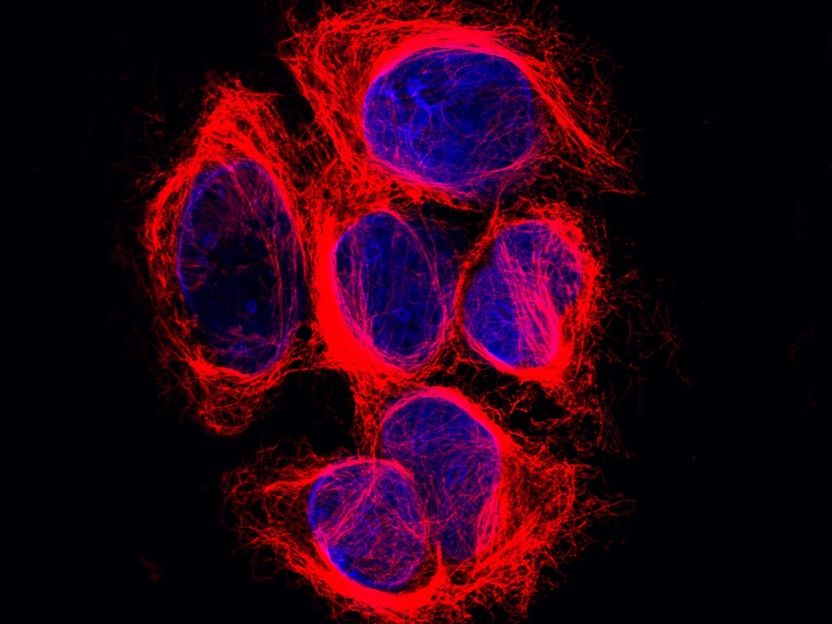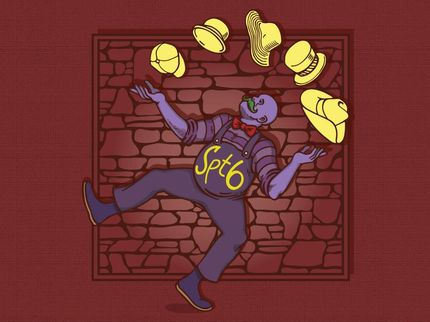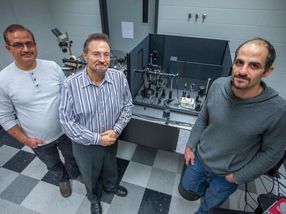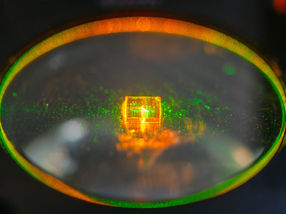Unexpected finding solves 40-year old cytoskeleton mystery
Scientists have been searching for it for decades: the enzyme that cuts the amino acid tyrosine off an important part of the cell’s skeleton. Researchers of the Netherlands Cancer Institute have now identified this mystery player, which may be of vital importance to the understanding of cell function and division, and therefore the understanding of cancer.

6 melanoma cells. Their DNA (blue) is found in the nucleus of the cells, their microtubules (red) in the cytoplasm, surrounding the nucleus.
The Netherlands Cancer Institute
Just like the human body as a whole, each human cell has a skeleton it needs for functioning properly. That so-called cytoskeleton allows a cell to maintain its shape, move to different places and transport molecules through its interior. Long chains called microtubules form an important part of that skeleton and function as a highway for the transport of molecules. For example, microtubules play a key role in cell division by allowing the cell to meticulously align their chromosomes before dividing them amongst daughter cells. Their crucial importance to the cell is easily illustrated by the working mechanism of a widely used group of cancer medicines called taxanes: they disrupt microtubule function and thereby kill dividing cells.
Mystery player
It has been suggested that proper transport at this crucial moment in the cell cycle involves detyrosination, in which the amino-acid tyrosine is removed from the tail of one of the microtubules’ main building block: α-tubulin. Over the past four decades scientist have been searching for the main actor in this process. Despite its importance for several cellular processes it remained unknown which enzyme takes off the tyrosine.
Researchers of the Netherlands Cancer Institute have now solved this puzzle by unmasking the mystery player. By using their recently developed innovate genetic screening method Joppe Nieuwenhuis and his colleagues identified the small SVBP protein as being a crucial part of the process. This small protein binds – and thereby stabilizes – proteins called vasohibins, which appear to have tubulin detyrosination activity. Nieuwenhuis: “These findings are surprising, because vasohibins were thought to function outside the cell and only recently it was predicted that these proteins might function as enzymes, without knowing their function.”
Hard puzzle
Now just how did Nieuwenhuis and his colleagues at Thijn Brummelkamp’s lab find these key molecular players? By using genome wide random mutations in human cells containing just one copy of each gene. Subsequently they selected the cells in which the studied process of detyrosination was broken due to one of the randomly introduced mutations. Selecting the cells with very little detyrosinated tubulin they discovered these cells had a mutated (and therefore dysfunctional) SVBP gene. Further experiments confirmed the interaction with vasohibins and its effect on tubulin detyrosination.
“For cell biologists this could be an important step”, says Nieuwenhuis. “We have found a piece of the puzzle that scientist have been staring at for many years because the process of detyrosination was discovered 40 years ago. This knowledge could be relevant to further understand the processes of mitosis, cell migration and cancer development. It is already found that the invasive front in some tumor tissues, where cells are migrating most actively, contains a high amount of detyrosinated tubulin. It is interesting to speculate that inhibition of detyrosination could be beneficial under certain conditions.”
Original publication
Nieuwenhuis, Joppe and Adamopoulos, Athanassios and Bleijerveld, Onno B. and Mazouzi, Abdelghani and Stickel, Elmer and Celie, Patrick and Altelaar, Maarten and Knipscheer, Puck and Perrakis, Anastassis and Blomen, Vincent A. and Brummelkamp, Thijn R.; "Vasohibins encode tubulin detyrosinating activity"; Science; 2017
Most read news
Original publication
Nieuwenhuis, Joppe and Adamopoulos, Athanassios and Bleijerveld, Onno B. and Mazouzi, Abdelghani and Stickel, Elmer and Celie, Patrick and Altelaar, Maarten and Knipscheer, Puck and Perrakis, Anastassis and Blomen, Vincent A. and Brummelkamp, Thijn R.; "Vasohibins encode tubulin detyrosinating activity"; Science; 2017
Topics
Organizations
Other news from the department science

Get the analytics and lab tech industry in your inbox
By submitting this form you agree that LUMITOS AG will send you the newsletter(s) selected above by email. Your data will not be passed on to third parties. Your data will be stored and processed in accordance with our data protection regulations. LUMITOS may contact you by email for the purpose of advertising or market and opinion surveys. You can revoke your consent at any time without giving reasons to LUMITOS AG, Ernst-Augustin-Str. 2, 12489 Berlin, Germany or by e-mail at revoke@lumitos.com with effect for the future. In addition, each email contains a link to unsubscribe from the corresponding newsletter.
























































